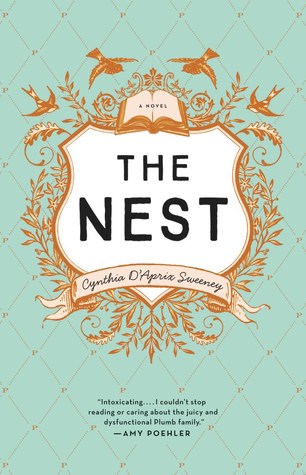
News
Cambridge Residents Slam Council Proposal to Delay Bike Lane Construction

News
‘Gender-Affirming Slay Fest’: Harvard College QSA Hosts Annual Queer Prom

News
‘Not Being Nerds’: Harvard Students Dance to Tinashe at Yardfest

News
Wrongful Death Trial Against CAMHS Employee Over 2015 Student Suicide To Begin Tuesday

News
Cornel West, Harvard Affiliates Call for University to Divest from ‘Israeli Apartheid’ at Rally
'The Nest' Fresh and Evocative
"The Nest" by Cynthia D'Aprix Sweeney (Ecco)

“Read these pages and tell me they’re good and let me have them and bear my fucking joy,” says Bea, a character in “The Nest.” These orders might have come straight from Cynthia D’Aprix Sweeney’s mouth herself, and tearing through this page-turner, readers can’t help but obey them. Much anticipated and highly praised, Sweeney’s debut novel rises to the occasion. “The Nest” follows the four Plumb siblings as their lives approach the dreaded, inevitable impending implosion of the mid-life crisis they will each face. After firstborn Leo’s untimely lust-and-drug-induced car accident, their family inheritance—the Nest—disappears. The remaining Plumb siblings must scramble around New York to demand that Leo repay the money they banked on to ease their financial and personal problems—problems for which they themselves are responsible. While a story about the downward spiral of a dysfunctional family is itself far from a novel idea, Sweeney puts her MFA from the Bennington Writing Seminar to use, weaving originality into the story. She does so by bringing together a colorful cast of characters, uniting their many different narratives through an underlying but omnipresent tone that reflects their self-absorption, to paint a mosaic of the many different times, types of people, and kinds of love that can be found in New York City.
Each dysfunctional Plumb sibling is a caricature of a different member of the upper class. Leo, the oldest, is the soon-to-be-divorced, rich, cheating, drug-dabbling socialite; Jack, the gay, husband-mooching antique shop owner; Beatrice, the once-promising writer who has lost her inspiration, among other things; and Melody, the increasingly desperate mother still naive enough to believe that everything will all work out. Throw in a couple of Bronx amputees, a 9/11 widower, a red-headed Brooklynite, a pair of college-bound teenage twins, and a friend-zoned magazine publisher, and readers have one eclectic cast of characters. Impressively enough, Sweeney rarely loses her reader despite juggling these many different narratives. Their strong voices and individual personalities bring life to their respective pages, clearly delineating where one section cedes into another. The characters themselves aren’t likeable as people—most of them are too selfish and gullible—but they’re attractive because they’re easy to relate to. From Melody’s fear of not being able to pay her daughters’ eventual expensive college tuitions to Leo running away from his responsibilities, Sweeney ascribes to each of her characters something with which anyone can connect.
Raised in a wealthy home with absentee parents, the Plumbs have a distorted notion of what family is. With a story and characters that border on expected and trite, Sweeney’s resistance to sap proves to be an impressive feat. She avoids delving into the saccharine and cheesy by adding an almost sardonic tone to her writing. “How many blow jobs for a Sub-Zero? ...a trip to Paris? Ten? One?” Melody wonders about the stay-at-home Westchester moms whose financial freedom she envies. The novel takes on a nearly arrogant timbre inherent to the main characters’ own delusions about themselves. They believe, naively, that the Nest’s inheritance is something they are owed, something they can fall back on in a world where nothing is free, and Sweeney’s writing reflects this gilded vision.
Another innovation comes in the seamless interweaving of the many different eras and neighborhoods of New York, the book’s setting. Sweeney goes from the modern day to late ’80s/early ’90s Greenwich Village—where “Jack [had] a very particular goal in mind: to have sex, lots and lots of sex”— to the post-9/11 city, from Manhattan’s skyscrapers to Brooklyn’s “neat blocks of brownstones, the daffodils and pansies in the window boxes, the number of families out on the street pushing strollers….” Sweeney explores the memories that shaped the Plumbs into the people they are in the novel and even flashes forward into certain futures, in a masterful display of manipulation of New York’s time and space. Her understanding and incorporation of New York into the novel concretizes the story, making the place just as tangible a character as the others.
Despite dealing with material that could easily slip into the mundane and clichéd, Sweeney’s triumphant debut novel is anything but. While the story’s plot revolves around Leo and his car accident, the novel is ultimately about family and how money can bring a family together or tear it apart. A funny, satirical depiction of a New York family at its worst, “The Nest” is an incisive commentary on the selfishness and dependence rampant in many wealthy families.
—Staff writer Mila Gauvin II can be reached at mila.gauvin@thecrimson.com.
Want to keep up with breaking news? Subscribe to our email newsletter.
